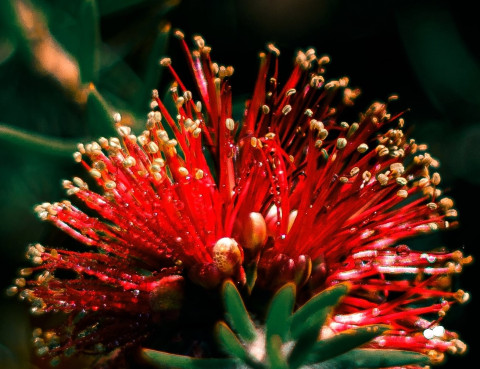This project is led by the Mauao Trust.
As a maunga tapu, Mauao is integral to the cultural identity of the people of Tauranga Moana. The uniqueness of Mauao extends both culturally and geographically, with the maunga in close proximity to the port of Tauranga. This location offers potential for Mauao to act as a sentinel, being both an indicator for biosecurity incursions as well as a ‘guardian’ of the surrounding area.

Myrtle rust is now affecting Mauao’s native pōhutukawa population. Pōhutukawa cover a large area of Mauao and are important in preventing erosion. Over time the maunga has also been planted with Kermadec pōhutukawa, which may have subsequently hybridised with trees native to Mauao. For mana whenua, questions arise as to whether non-native and hybridised trees should be removed, particularly if these trees are susceptible to myrtle rust. Genomics Aotearoa proudly supports this project to initiate building Mauao as a sentinel for biosecurity, using pōhutukawa and its susceptibility to myrtle rust as a first case study.
This project will utilise genomics to understand pōhutukawa whakapapa. Researchers will work with Tauranga Moana hapū and directly with the Mauao Trust, to determine the status of individual pōhutukawa trees as either native or introduced to Mauao. Understanding the diversity of pōhutukawa will help mitigate the impact of pests and pathogens and will facilitate further myrtle rust resistance work.
This research aligns with and supports the care plan for Mauao and strategy for the Mauao Trust - He Korowai Ariki o Mauao. Importantly, the research also contributes to local capability building through the engagement of a Masters student, who will receive guidance and supervision from both Te Ao Māori and scientific perspectives.
Project outcomes include:
- Identification of key native, non-native and hybrid pōhutukawa.
- Capacity and capability building for iwi and hapū.
- Methodologies and local expertise that can help mitigate the impact of future biosecurity incursions.
- Building a track record for research surveillance and monitoring of host species and pest pathogens.
Project team:
- Heidi Dungey, Scion (lead)
- Kia Māia Ellis, Mauao Trust and University of Waikato
- Josh Clark, Tauranga District Council